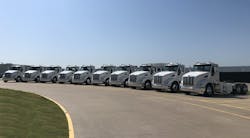Peterbilt has delivered 10 Model 579EVs to Shippers Transport Express for immediate use as part of their drayage operations at the Port of Oakland.
Five additional Model 579EVs are scheduled to be put into service as part of their Port of Long Beach drayage operations in November.
Founded in 1993, Shippers Transport specializes in the movement of goods from ports to local distribution centers. Based out of Carson, California, Shippers Transport operates out of four ports up and down the West Coast of the United States.
“With the recent completion of the charging infrastructure at the Port of Oakland, right now is the perfect time to put our 10 Peterbilt Model 579EVs into service and demonstrate the benefits zero-emission trucks will provide moving cargo around our California ports,” said Guy Sanderson, GM, Shippers Oakland.
The fully integrated, battery-electric 579EV in operation by Shippers Transport is optimized for drayage operations requiring two to three trips a day, of up to 50 miles in length before returning home at night to recharge. When used in conjunction with a recommended DC fast-charger, the state-of-the-art, high-energy density battery packs recharge in three to four hours, Peterbilt says.
“The delivery of new Model 579EVs to Shippers Transport is another example of how Peterbilt’s battery-electric vehicles are hard at work with customers across the country in a variety of applications. We are very excited to see our 579EVs moving around the Port of Oakland with the Port of Long Beach set to come online shortly,” said Jason Skoog, Peterbilt GM and Paccar VP.
The order with Shipper’s Transport Express is part of a $50 million grant obtained from the California Air Resources Board’s Zero and Near Zero Emission Freight Facility (ZANZEFF) program. ZANZEFF funds transform emissions-reduction strategies at freight facilities throughout the state. The project is also part of California Climate Investments, a statewide initiative that puts billions of Cap-and-Trade dollars to work reducing greenhouse gas emissions, strengthening the economy and improving public health and the environment--particularly in disadvantaged communities.




